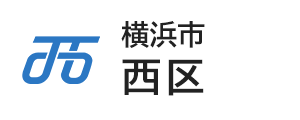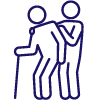- Yokohama-shi Top Page
- Nishi Ward Top Page
- Introduction of the ward
- Sightseeing
- Recommended course
- History walk
- Nishi Ward History Walk Michi Old Tokaido
Here's the text.
Nishi Ward History Walk Michi Old Tokaido
Last Updated January 17, 2019
In the past, from the current area around Yokohama Station to Kubocho, it was an inner bay called Sodegaura. The old Tokaido was connected from Kanagawa-juku to Hodogaya-juku along the sea (currently from Kusunoki-cho to Sengencho). The area was famous as a very scenic place, with white sails floating in a quiet cove.
During the Edo period, there was a position between the inn and the inn along the highway as a resting place for people and horses. The lawn village (Shibomura / current Sengencho) between Kanagawa-juku and Hodogaya-juku was developed in this position, and in addition to the farm, commerce such as selling Iiya, sake and straw was also engaged in commerce.
Kangyo-ji Temple
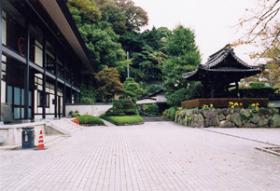
9, Minamikaruizawa
It opened in 1595 (1595). The main ancestor is the Great Mandala, one tower and one tower. Immediately after entering the gate, there is a tomb (memorial tower) of Kondo built-in assistant director Hirohiro. He was the founder of the sword method called Natural Rishinryu, and Isami Kondo, who left his name as the captain of the Shinsengumi, is said to be the fourth generation.
In addition, Yokohama-born writer Touma Kitamura and playwright Mrs. Yoshiko sleep, depicting Yokohama's exoticism. In the precincts, there is a ginkgo designated by Naki Furuki.
Koshin Pagoda in Karuizawa
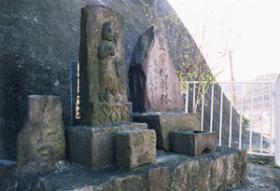
61, Minamikaruizawa
It was built on February 1779, Yasunaga 8th year. The monument behind the tower says, "This tower is located only in Nishi Ward at the time of its construction, despite the expansion of the road, and is located in 46 years of Tateyuki Showa (omitted) for preservation."
This tower stands on the right side of the cliff on the right side of the main local road Yokohama Ikuta Line to Mitsuzawa, along the stairs leading to Kanto Jidosha School.
At Koshin's event, an insect called Sanshaku escapes the human body while sleeping on the night of Koshin's day, which goes around once every 60 days, and reports the sin to the Emperor. Therefore, it is based on Taoism's teaching that he spends modestly and without sleeping on this day. It has been seen in Japan since the Heian period, and in the Edo period it changed its shape and spread to the common people. Nowadays, religion has declined, and only a tower engraved with the blue statue of Kongo, sun, moon, chicken, and three monkeys remain.
Asama Shrine
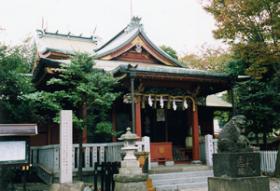
Sengencho 1-19-10
It is said that it worshiped the spirit of Fuji Asama Shrine for 4 years (1080). The god of the festival is Kihana Sakiya Himemei (Konohana Sakuya Himeno Mikoto) and guards the former lawn village. The main hall is 2 stories high. The hill where the shrine is located is called "Sodesuriyama", and it is said that in the past, the underneath the mountain was immediately on the shore.
There are 20 side cave tombs on the slope of this hill, of which the opening is called "Fuji's Hitoana", and the statue of Dainichi Nyorai, which was enshrined in it, is now located next to the shrine. .
Oiwake
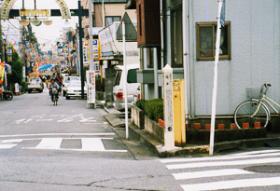
Around 350 Sengencho
The three-way intersection at the Hodogaya Ward border was famous on the Tokaido as a lawn Oiwake. Since it stretched to Hachioji-juku on the Koshu Kaido at the starting point of the Hachioji Road, it was bustling as a major road connecting the Tokaido and Koshu Kaido. Even after the opening of the port, it prospered as a transportation route for silk and other things, and when entering Hachioji Road from Oiwake, a small river flowed, a stone bridge was hung, and there was a reputed Dobrok shop. It is said that there were two old Jizo statues beyond that.
The stone monument of the end of Dr. Kimura
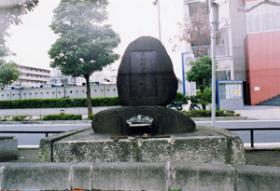
Asama Garage-mae Park
Mr. Kimura, the principal of Katabira Elementary School, invested his own money and built ![]() Rintoku Elementary School after Retirement. Born in 1853 (1853) as a child of a Sendai feudal lord, became a teacher in Kanagawa Prefecture in 1878 (1878), and later became the principal of Kabira Elementary School. In 1917 (1917), he built a private elementary school in Sengencho for children who could not go to school for various reasons. He consistently worked as an educator, saying that "humans work while they live," but ended his life due to the Great Kanto Earthquake of 1923 (1923). A volunteer who survives Kimura's virtue built a monument in Asama Garage Park.
Rintoku Elementary School after Retirement. Born in 1853 (1853) as a child of a Sendai feudal lord, became a teacher in Kanagawa Prefecture in 1878 (1878), and later became the principal of Kabira Elementary School. In 1917 (1917), he built a private elementary school in Sengencho for children who could not go to school for various reasons. He consistently worked as an educator, saying that "humans work while they live," but ended his life due to the Great Kanto Earthquake of 1923 (1923). A volunteer who survives Kimura's virtue built a monument in Asama Garage Park.
Kofukuji Temple
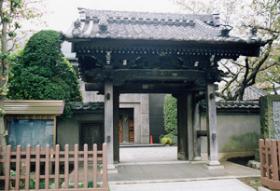
Sengencho 5-385-3
According to the temple biography, the opening of the mountain is said to be "Donkai". It is said that Sodesuriyama Yakushido was moved here in 1636 (1636). Honson Yakushi Nyorai is said to be the guardian principal of Gongoro Kamakura Keimasa, and is said to be a blind pharmacist.
Inquiries to this page
Nishi Ward General Affairs Department Regional Promotion Division
Telephone: 045-320-8389
Telephone: 045-320-8389
Fax: 045-322-5063
Email address: ni-chiikishinko@city.yokohama.lg.jp
Page ID: 484-741-453
